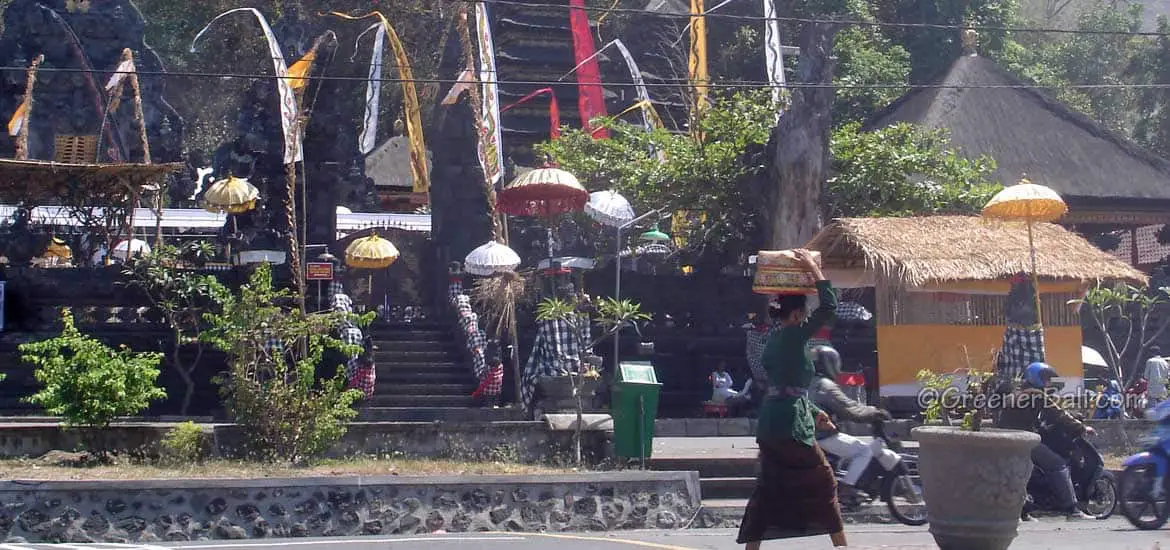Most of the East Bali sights are set along with the stunning landscapes that Bali is known for.
If you drive around East Bali on a clear day you are likely to be accompanied by the view of an impressive mountain: Mount Agung (or Gunung Agung).
Gunung Agung
The highest mountain on the island is also the holiest one for the Balinese. It is often referred to as the ‘Mother Mountain’ or the ‘Navel of the world’.

The Balinese believe that their gods reside on this mountain. The height of Mount Agung enables the gods to watch over the daily lives of the Balinese people. Not surprisingly Pura Besakih, the ‘Mother Temple’ for all the Hindu Balinese is located on the slopes of this mystical mountain.
However, while the Balinese worship their gods on this mountain, they have also experienced a lot of suffering. This active volcano erupted in 1963. It killed thousands of people, ruined buildings, crops and displacing many from their homes.
Miraculously many parts of the Mother Temple were still intact and could easily be restored to her original state.
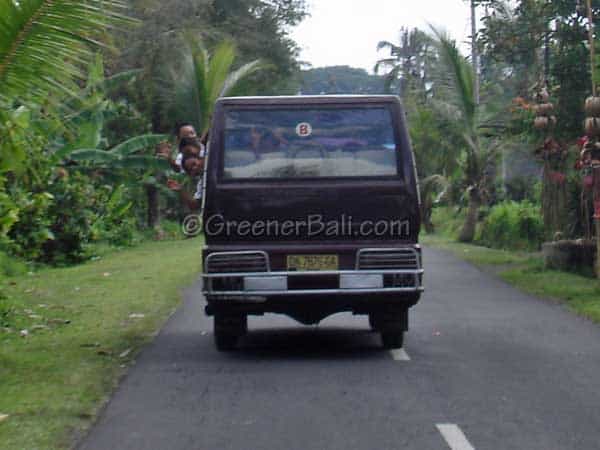
Today you can see the remains of the eruption when you drive around Tulamben. Signs of where the lava flowed are still visible on this barren side of the mountain. On the southern side of the mountain, the landscape is completely different.
Rice terraces
Here you’ll see amazing rice terraces as far as the eye can see. It is really an unbelievable sight to see how the Balinese people have been able to create these complicated irrigated rice terraces.
A great route to drive along these rice terraces is the road passing Sidemen and Rendang, making a detour to the Besakih temple.
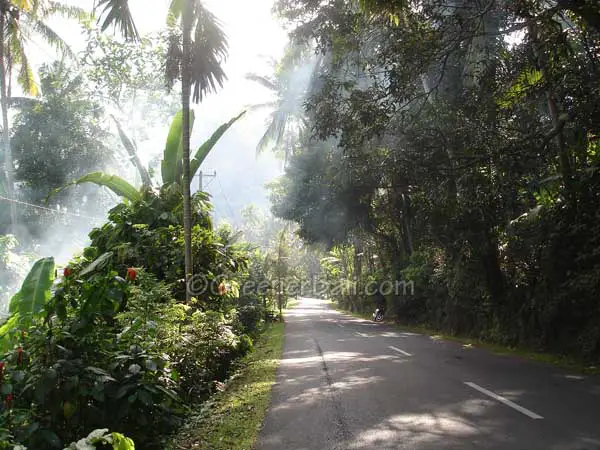
The Beaches
The beaches in this region are mainly volcanic black. They are often visited by travelers for good snorkeling and diving sights. The villages Padangbai, Amed and Tulamben located along the east coast are particularly popular. Tulamben is known for its shipwreck and the abundance of coral fish living around it.
Historical sights in East Bali
Besides the amazing vistas, there are many other East Bali sights located near the major cities which were once the capitals of mighty kingdoms.

Kamasan
This little village is where the Kamasan wayang painting style originated in the 14th century.
In the past, this was the only style of painting found in Bali. Talented painters were ordered by the king to decorate the palace and temples with Kamasan paintings.
The religious stories of the Mahabharata and the Ramayana were painted on long narrow canvases which could reach up to several meters in length. Today a couple of artists in Kamasan have workshops where you can still see this old painting style.
Palaces
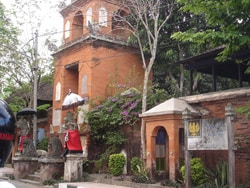 Puri Agung Karangasem
Puri Agung Karangasem
This royal temple and palace in Amplapura is the remains of the last kingdom of this region which lasted till the early 20th century.
Before the 1963 eruption of Gunung Agung, Amlapura was called Karangasem. The name change was considered a new beginning after the eruption had destroyed most parts of the city.
In Amlapura you can find one of the few remaining royal palaces which have survived during the Dutch colonial period. Unlike its neighboring kingdoms, the King of Karangasem, Anak Agung Agung Anglurah Ketut Karangasem cooperated with the Dutch rulers and so prevented any battles in the city.
On the palace grounds, there are signs of Dutch influences. The pavilion ‘Bale Pemandesan’ located between the main building and pond was used for royal tooth filling and cremation ceremonies. Around 100 descendants of the royal family still live here, not surprisingly when you know that the last king had 35 wives.
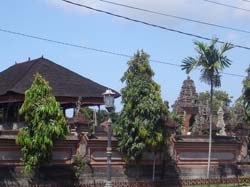 The palace Taman Gili
The palace Taman Gili
This palace was built in 1710 and was designed by Prince Dewa Agung Jambe I from Gelgel village. The raja ordered the best craftsmen in the kingdom to create a palace that had a mixture of Majapahit and former Balinese-Hindu influences.
Unfortunately, the palace was severely damaged in 1908 by the Dutch and has never been fully restored.
Within the palace walls, you can visit the former royal Hall of Justice, Kerta Gosa. Here unsettled village disputes were trialed before the king and higher priests. At the Bali Kambang, a floating pavilion, the king used to receive his guests.
At these two pavilions, there are paintings on the ceiling. In the Hall of Justice, these are Kamasan-style paintings, while at the floating pavilion the paintings portray stories of the astrological calendar, folk tales, and adventures of the hero Sutasoma.
Memorials
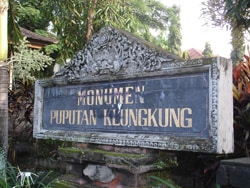 Semarapura
Semarapura
Between 1710 until 1908 this city, formerly known as Klungkung, was the center of the mighty Gelgel-dynasty which ruled over Java, Bali, Lombok, and the Sumbawa islands.
Today Balinese who belong to the noble society are mostly descendants of the royal Klungkung
family. Until his death in 1964 the last Raja of Klungkung, Ida I Dewa Agung Gede Oka Geg, was highly respected.
He survived the mass suicidal battle (called puputan) against the Dutch army in 1908 and returned to Bali after living in exile on the nearby island of Lombok. Until the end of his life, he lived in the Taman Gili palace with his 40 wives and 100 children. If you visit Klungkung you will easily find the palace on the main junction in the center of the city, across the puputan square.
Temples
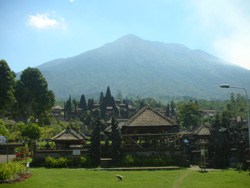 Pura Besakih
Pura Besakih
This temple is often referred to as the Mother Temple and is considered the most important by the Balinese people. Funny enough this temple is also the temple that should be avoided by tourists. Unfortunately, the annoying self-proclaimed guides who hang around the parking lot and entrance kind of make the visit to the temple a nightmare as they insist you can only visit the temple when you use their services.
I’ve been here a couple of times to study the impact of tourism and nothing much has changed during the years so visiting this temple is basically only for diehards.
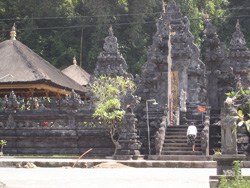 Pura Goa Lawah
Pura Goa Lawah
Travelers don’t visit this historical site for the temple but for the holy bat cave. To reach it you must pass the very old Temple of Death, Pura Dalem, which is still used and considered very important to the Balinese.
The Balinese believe that Naga Basuki, a huge snake, lives in the bat cave. Naga Besuki is the gatekeeper of the balance on earth and is worshiped in the temple.
It is said that in the cave there is an underground tunnel that leads you all the way to the Besakih temple,
located 25 km from the cave entrance. However, don’t plan to do some crawling from the cave to the Besakih temple because it is forbidden to enter the cave.
Water Palaces
 Tirta Gangga Water Palace
Tirta Gangga Water Palace
Just north of Amlapura, you can find one of the most beautiful water palaces in Bali. This water palace has several pools that are surrounded by a beautiful garden, fish ponds, and many statues.
It is possible to take a swim in this amazing setting. The fresh spring water is freezing though but after swimming a couple of laps you’ll feel like royalty yourself.
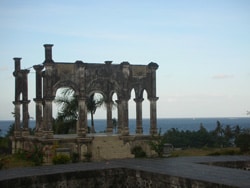 Taman Ujung
Taman Ujung
The King of Karangasem built this water palace in 1921. At that time the water palace really looked like a royal palace and some describe it as a miniature of the Taj Mahal.
However, due to lack of maintenance and the earthquake damages in 1979, the water palace has lost its grandeur. You can still wander around and admire the view though.
Others
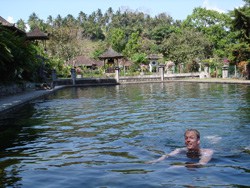 The Bali Aga Village Tenganan and Trunyan
The Bali Aga Village Tenganan and Trunyan
The original descendants of Bali prior to the Majahapit arrival live together in two villages, one located near Candidasa while the other at the shores of Lake Batur.
While the Bali Aga at both villages lives according to ancient rules, they do differ from each other. Tenganan looks very basic but the villagers are one of the richest people on the island and are welcoming towards visitors.
Trunyan, on the other hand, is less easy to reach making this village more isolated for outsiders. As expected, not many travelers venture here.
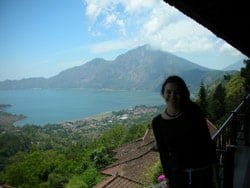 Gunung Batur
Gunung Batur
Mount Batur (1717 m) (Gunung Batur) is one of the most popular tourist stops in Bali. Many tours take the route to Kintamani for the stunning view of the active volcano and the largest crater lake (if the weather permits).
To fully appreciate this area you can stay at the nearby villages and climb the mountain in the early morning…

